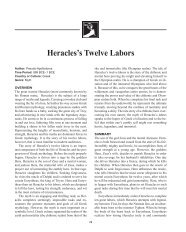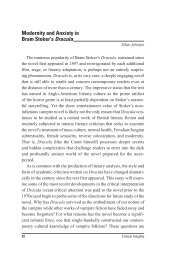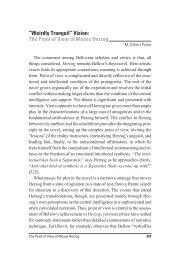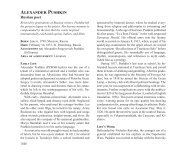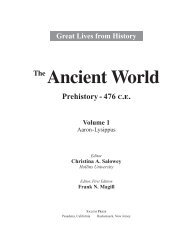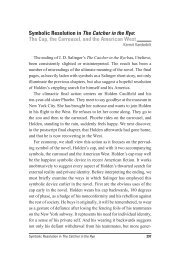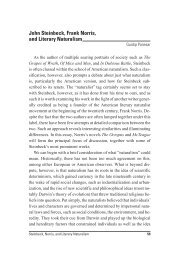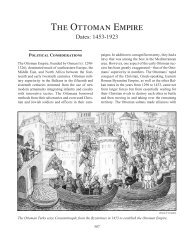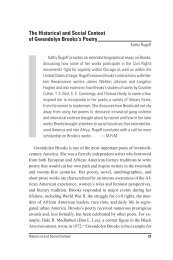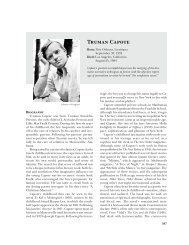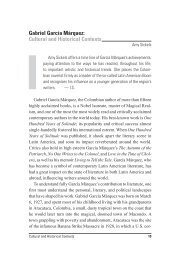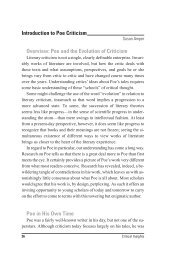“A Fragment of Lost Words”: Narrative Ellipses in The ... - Salem Press
“A Fragment of Lost Words”: Narrative Ellipses in The ... - Salem Press
“A Fragment of Lost Words”: Narrative Ellipses in The ... - Salem Press
Create successful ePaper yourself
Turn your PDF publications into a flip-book with our unique Google optimized e-Paper software.
cance” it once did (93). He says, “Now it was aga<strong>in</strong> a green light on a<br />
dock. His count <strong>of</strong> enchanted objects had dim<strong>in</strong>ished by one” (93).<br />
Someth<strong>in</strong>g <strong>of</strong> the same effect may be at work for Nick himself, for<br />
Gatsby, <strong>in</strong> tell<strong>in</strong>g his story, becomes an ord<strong>in</strong>ary man rather than an enchanted<br />
figure <strong>of</strong> <strong>in</strong>f<strong>in</strong>ite possibility.<br />
At the novel’s conclusion, Nick uses ellipses to a different effect, <strong>in</strong>dicat<strong>in</strong>g<br />
neither time lost to a drunken blackout nor a transition between<br />
his own “present tense” narrative and the imbedded narratives <strong>of</strong><br />
Gatsby’s past. In his last encounter with Tom Buchanan, ellipses <strong>in</strong>stead<br />
speak to the tension between Nick’s impulses toward reflection<br />
and narration. A narratologist might take his terms from Aristotle, call<strong>in</strong>g<br />
these two elements <strong>of</strong> the narrative discourse diegesis (commentary)<br />
and mimesis (representation); a layman might term this the dist<strong>in</strong>ction<br />
between tell<strong>in</strong>g and show<strong>in</strong>g. Nick encounters Tom by chance<br />
on Fifth Avenue <strong>in</strong> October. Tom spots him and thrusts out his hand,<br />
ask<strong>in</strong>g, “What’s the matter, Nick? Do you object to shak<strong>in</strong>g hands with<br />
me?” Nick tells him he does, and asks Tom whether he told Wilson<br />
who owned the yellow car. Tom defends his actions, say<strong>in</strong>g “What if I<br />
did tell him? That fellow had it com<strong>in</strong>g ...Heranover Myrtle like<br />
you’d run over a dog and never even stopped his car” (178). Nick<br />
knows the truth <strong>of</strong> the matter—that Daisy, not Gatsby, was driv<strong>in</strong>g—<br />
yet he chooses not to tell Tom. He muses, “<strong>The</strong>re was noth<strong>in</strong>g I could<br />
say, except the one unutterable fact that it wasn’t true” (178). Aga<strong>in</strong><br />
and aga<strong>in</strong>, Nick has chosen to keep silent. He does so aga<strong>in</strong> here, perhaps<br />
feel<strong>in</strong>g that no facts, no matter how true, could shake Tom’s op<strong>in</strong>ion<br />
<strong>of</strong> himself as “entirely justified.” He th<strong>in</strong>ks:<br />
<strong>The</strong>y were careless people, Tom and Daisy—they smashed up th<strong>in</strong>gs and<br />
creatures and then retreated back <strong>in</strong>to their money or their vast carelessness,<br />
or whatever it was that kept them together, and let other people clean<br />
up the mess they made. ...<br />
I shook hands with him; it seemed silly not to, for I felt suddenly as<br />
though I were talk<strong>in</strong>g to a child. (179)<br />
<strong>“A</strong> <strong>Fragment</strong> <strong>of</strong> <strong>Lost</strong> <strong>Words”</strong> 201



